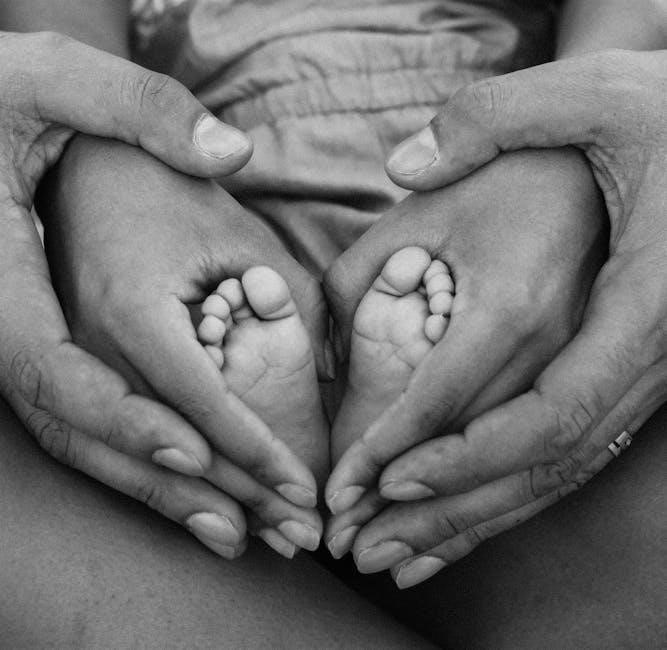Overview of Birth Positions
Birth positions encompass a variety of postures a woman can adopt during labor and delivery. These positions aim to optimize comfort, facilitate labor progress, and potentially reduce pain. Exploring different birth positions can empower women to feel more in control.
Importance of Choosing the Right Birth Position
Selecting an appropriate birth position holds significant importance in influencing labor progression and overall maternal comfort. A well-chosen position can optimize pelvic dimensions, facilitating the baby’s descent through the birth canal. Furthermore, certain positions may alleviate back pain, a common discomfort during labor. Upright birth positions, for instance, have been associated with shorter labor durations and reduced need for interventions. The ideal position varies among individuals, influenced by factors like fetal positioning and personal preferences. Experimentation and guidance from healthcare providers are vital in identifying the most beneficial and comfortable birth position. Ultimately, the right choice empowers the birthing person.
Upright Birth Positions
Upright birth positions utilize gravity to aid the baby’s descent, potentially shortening labor. These positions include standing, walking, squatting, and kneeling. They can enhance comfort and promote more efficient contractions.
Benefits of Upright Positions (e.g., shorter labor, less pain)
Upright birth positions offer several advantages during labor. They can lead to a shorter first stage of labor by utilizing gravity to facilitate the baby’s descent. Moreover, these positions may reduce pain by improving blood flow and allowing for more effective contractions. Women often report feeling more empowered and in control when using upright positions. Studies suggest a lower likelihood of needing interventions like epidurals or cesarean sections with upright birth positions. These positions also promote better oxygenation for both mother and baby, contributing to a safer and more comfortable birthing experience. They can positively influence the overall birth experience.
Recumbent Birth Positions
Recumbent birth positions involve lying down during labor and delivery. These positions, such as side-lying or semi-reclining, offer rest and can be beneficial in certain situations. It can be used to help labor progress.
Description of Lying-Down Positions (e.g., semi-reclining, side-lying)
Lying-down positions offer varied options for labor and delivery. Semi-reclining involves being propped up in bed, providing some elevation while still offering support. Side-lying entails lying on either your left or right side, often with pillows for comfort between the legs. This position can aid in fetal positioning and promote blood flow. These recumbent birth positions may be preferred with an epidural as they require less effort to maintain. Resting passively between contractions can be very beneficial in these positions.
Positions with Epidural
Positions with epidural anesthesia often involve reclining or side-lying. These positions offer stability and comfort when mobility is limited. Healthcare providers can guide you to find effective and safe birth positions.
Effective Positions When Using Epidural Anesthesia
When using epidural anesthesia, certain birth positions can still be effective in promoting labor progress and fetal descent. Side-lying is a comfortable option, allowing for pelvic relaxation and reducing pressure on the vena cava. Semi-reclining positions with pillows for support can also be beneficial, facilitating gravity’s assistance without excessive strain. Leaning forward on a birthing ball or the bed can help to open the pelvis. Frequent position changes, even with limited mobility, are encouraged to optimize fetal positioning and maternal comfort. Healthcare providers can guide you.

Positions for Each Stage of Labor
Different birth positions are suited for each stage of labor, optimizing comfort and progress. The first stage focuses on opening the cervix, while the second involves pushing the baby out.
Positions for the First Stage of Labor
During the initial phase of labor, which focuses on cervical dilation, various birth positions can aid comfort and progress. Upright positions, such as walking, standing, or swaying, can utilize gravity to encourage the baby’s descent. Leaning forward on a support, like a birth ball or partner, can ease back pain. Rhythmic movements, like rocking, can offer soothing relief. Side-lying positions provide rest while maintaining pelvic openness. Experimenting with different birth positions during the first stage helps manage pain and promote efficient labor progression, letting the body guide you.
Positions for the Second Stage of Labor (Pushing)
The second stage, focused on pushing the baby out, benefits from positions that maximize pelvic diameter and maternal effort. Squatting, either supported or unsupported, opens the pelvic outlet. Kneeling or hands-and-knees positions can alleviate pressure on the back and coccyx. Side-lying allows for rest between contractions and can be helpful with an epidural. Upright positions, if comfortable, continue to utilize gravity. Listen to your body and work with your care provider to find positions that feel effective and support a safe, efficient delivery during this demanding stage of labor.

Tools and Support for Different Positions
Various tools and supportive measures can aid in achieving comfortable and effective birth positions. Birth balls, supportive partners, and skilled doulas can empower women. These resources promote mobility and provide assistance during labor.
Using a Birth Ball
A birth ball offers versatile support during labor. Sitting on it promotes an upright position, potentially aiding fetal descent. Gentle bouncing or rocking can ease back pain and encourage pelvic movement. Leaning over the ball in a kneeling position can relieve pressure and provide comfort. It is a valuable tool for managing labor discomfort. The birth ball promotes mobility and offers a sense of control. Using a birth ball can lead to an easier, more comfortable, and empowered birth experience by encouraging optimal fetal positioning and reducing the need for interventions.
Partner Support and Guidance
A supportive partner plays a crucial role during labor. Offering encouragement and physical assistance can empower the birthing person. Partners can help maintain comfortable positions, provide counter-pressure for pain relief, and offer emotional support. Guiding the birthing person through breathing techniques and position changes can enhance coping mechanisms. Being attentive to their needs and preferences fosters a positive birth experience. Their presence and assistance contribute significantly to the birthing person’s comfort and confidence. Partner support can help to create a calm and controlled environment, which can lead to a more pleasant and positive birth experience.

Fetal Positioning and Birth Positions
Fetal positioning significantly impacts labor. Certain birth positions can encourage optimal fetal alignment. This alignment helps the baby navigate the pelvis more efficiently, potentially shortening labor and reducing complications.
How Birth Positions Can Help Correct Fetal Malposition
Birth positions play a crucial role in addressing fetal malposition during labor. When a baby isn’t ideally positioned, such as in a breech or posterior position, specific postures can encourage rotation. Upright positions, like squatting or kneeling, utilize gravity to help the baby descend and turn. Leaning forward or using a birth ball can also create space in the pelvis, facilitating fetal movement. Changing positions frequently encourages the baby to find the optimal path. Skilled birth attendants can guide mothers in selecting positions that address specific fetal positioning challenges, potentially avoiding interventions.
Benefits of Changing Positions During Labor
Changing positions during labor offers numerous benefits, including pain management, increased comfort, and promoting labor progress. Movement and varied postures can help the baby descend and rotate, potentially shortening labor.
Pain Management and Comfort
Different birth positions can significantly impact pain perception and overall comfort during labor. Upright positions, for example, may utilize gravity to ease the baby’s descent, potentially reducing back pain. Changing positions prevents prolonged pressure on specific areas. This promotes better circulation and reduces discomfort. Experimenting with various positions like leaning, kneeling, or using a birth ball can help women discover what feels most comfortable and provides optimal pain relief during labor, empowering them to actively manage their experience. Finding a comfortable birth position can help you feel more in control.
Promoting Labor Progress
Strategic use of birth positions can actively influence the progression of labor. Upright positions, such as standing or walking, harness gravity to aid the baby’s descent through the birth canal, potentially shortening the first stage of labor. Certain positions can also help optimize the baby’s position within the pelvis. This facilitates easier passage during contractions. Changing positions encourages fetal rotation and alignment. These adjustments promote efficient and effective labor. Utilizing various birth positions can contribute to a smoother and potentially faster delivery process by positively impacting labor’s natural progression.

Resources and Guides for Birth Positions
Numerous resources exist to guide expectant mothers on birth positions. These include guides, charts, and visual aids. Such resources offer valuable information for informed decision-making and preparation for labor and delivery.
PDF Guides and Charts for Visual Learning
PDF guides and charts offer a visually accessible way to explore various birth positions. These resources often include illustrations demonstrating each position, highlighting its potential benefits for both mother and baby. They provide a quick reference for understanding how different postures can influence labor progress, pain management, and fetal positioning. Many guides also offer tips for adapting birth positions to individual needs and preferences, ensuring a more comfortable and empowered birthing experience. Accessing such resources allows expectant parents to visualize and discuss options with their healthcare providers, promoting informed choices during labor.
